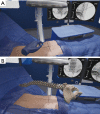Virtual reality in spinal endoscopy: a paradigm shift in education to support spine surgeons
- PMID: 32195429
- PMCID: PMC7063305
- DOI: 10.21037/jss.2019.11.16
Virtual reality in spinal endoscopy: a paradigm shift in education to support spine surgeons
Abstract
Background: Minimally invasive spine surgery (MISS) and endoscopic spine surgery have continually evolving indications in the cervical, thoracic, and lumbar spine. Endoscopic spine surgery entails treatment of disc disease, stenosis, spondylolisthesis, radiculopathy, and deformity. MISS involves complex motor skills in regions of variable anatomy. Simulator use has been proposed to aid in training and skill retention, preoperative planning, and intraoperative use.
Methods: A systematic review of five databases was performed for publications pertaining to the use of virtual (VR), augmented (AR), and mixed (MR) reality in MISS and spinal endoscopic surgery. Qualitative data analysis was undertaken with focus of study design, quality, and reported outcomes. Study quality was assessed using the Medical Education Research Quality Instrument (MERSQI) score and level of evidence (LoE) by a modified Oxford Centre for Evidence-Based Medicine (OCEBM) level for simulation in medicine.
Results: Thirty-eight studies were retained for data collection. Studies were of intervention-control, clinical application, and pilot or cross-sectional design. Identified articles illustrated use of VR, AR, and MR in all study designs. Procedures included pedicle cannulation and screw insertion, vertebroplasty, kyphoplasty, percutaneous transforaminal endoscopic discectomy (PTED), lumbar puncture and facet injection, transvertebral anterior cervical foraminotomy (TVACF) and posterior cervical laminoforaminotomy. Overall MERSQI score was low-to-medium [M =9.71 (SD =2.60); range, 4.5-13.5], and LoE was predominantly low given the number of purely descriptive articles, or low-quality randomized studies.
Conclusions: The current scope of VR, AR, and MR surgical simulators in MISS and spinal endoscopic surgery was described. Studies demonstrate improvement in technical skill and patient outcomes in short term follow-up. Despite this, overall study quality and levels of evidence remain low. Cohesive study design and reporting with focus on transfer validity in training scenarios, and patient derived outcome measures in clinical studies are required to further advance the field.
Keywords: Virtual reality (VR); minimally invasive spine surgery (MISS); simulator; spinal endoscopic surgery.
2020 Journal of Spine Surgery. All rights reserved.
Conflict of interest statement
Conflicts of Interest: Dr. DP Goel is the CEO of PrecisionOS Technology, a virtual reality company. The other authors have no conflicts of interest to declare.
Figures



Similar articles
-
Virtual, Augmented, and Mixed Reality Applications for Surgical Rehearsal, Operative Execution, and Patient Education in Spine Surgery: A Scoping Review.Medicina (Kaunas). 2024 Feb 15;60(2):332. doi: 10.3390/medicina60020332. Medicina (Kaunas). 2024. PMID: 38399619 Free PMC article.
-
Percutaneous transforaminal endoscopic discectomy compared with microendoscopic discectomy for lumbar disc herniation: 1-year results of an ongoing randomized controlled trial.J Neurosurg Spine. 2018 Mar;28(3):300-310. doi: 10.3171/2017.7.SPINE161434. Epub 2018 Jan 5. J Neurosurg Spine. 2018. PMID: 29303469 Clinical Trial.
-
Augmented and virtual reality in spine surgery, current applications and future potentials.Spine J. 2021 Oct;21(10):1617-1625. doi: 10.1016/j.spinee.2021.03.018. Epub 2021 Mar 25. Spine J. 2021. PMID: 33774210 Review.
-
Utility of Augmented Reality and Virtual Reality in Spine Surgery: A Systematic Review of the Literature.World Neurosurg. 2022 May;161:e8-e17. doi: 10.1016/j.wneu.2021.08.002. Epub 2021 Aug 9. World Neurosurg. 2022. PMID: 34384919
-
Feasibility of Virtual Reality Combined with Isocentric Navigation in Transforaminal Percutaneous Endoscopic Discectomy: A Cadaver Study.Orthop Surg. 2019 Jun;11(3):493-499. doi: 10.1111/os.12473. Epub 2019 Jun 17. Orthop Surg. 2019. PMID: 31207133 Free PMC article.
Cited by
-
Virtual Reality in the Neurosciences: Current Practice and Future Directions.Front Surg. 2022 Feb 18;8:807195. doi: 10.3389/fsurg.2021.807195. eCollection 2021. Front Surg. 2022. PMID: 35252318 Free PMC article. Review.
-
Navigation Techniques in Endoscopic Spine Surgery.Biomed Res Int. 2022 Aug 29;2022:8419739. doi: 10.1155/2022/8419739. eCollection 2022. Biomed Res Int. 2022. PMID: 36072476 Free PMC article. Review.
-
Using virtual reality in lumbar puncture training improves students learning experience.BMC Med Educ. 2022 Apr 4;22(1):244. doi: 10.1186/s12909-022-03317-7. BMC Med Educ. 2022. PMID: 35379253 Free PMC article.
-
XR (Extended Reality: Virtual Reality, Augmented Reality, Mixed Reality) Technology in Spine Medicine: Status Quo and Quo Vadis.J Clin Med. 2022 Jan 17;11(2):470. doi: 10.3390/jcm11020470. J Clin Med. 2022. PMID: 35054164 Free PMC article. Review.
-
Virtual, Augmented, and Mixed Reality Applications for Surgical Rehearsal, Operative Execution, and Patient Education in Spine Surgery: A Scoping Review.Medicina (Kaunas). 2024 Feb 15;60(2):332. doi: 10.3390/medicina60020332. Medicina (Kaunas). 2024. PMID: 38399619 Free PMC article.
References
LinkOut - more resources
Full Text Sources
Research Materials
